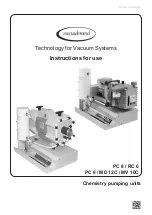
11
ENGLISH
Spark Plug Service
Recommended Spark Plug: NGK - BPR6ES
NOTICE
Incorrect spark plugs can cause engine damage.
For good performance, the spark plug must be properly gapped and
free of deposits.
Allow the engine to cool before servicing the spark plug.
1. Disconnect the spark
plug cap [1] and
remove any dirt from
around the spark plug
area.
2. Use a spark plug
wrench [2] to remove
the spark plug.
3. Visually inspect the
spark plug. Discard it if
the insulator is
cracked, chipped, or
fouled.
4. Measure the plug gap
with a suitable gauge.
Correct as necessary
by carefully bending
the side electrode.
Plug gap:
0.7 ~ 0.8 mm
5. Check that the spark
plug washer is in good
condition, and thread the
spark plug in by hand to
prevent cross-threading.
6. After the spark plug is
seated, tighten with a
spark plug wrench to
compress the washer.
If installing a new spark plug, tighten 1/2 turn after the spark plug
seats to compress the washer.
If reinstalling a used spark plug, tighten 1/8 - 1/4 turn after the
spark plug seats to compress the washer.
NOTICE
A loose spark plug can overheat and damage the engine.
Overtightening the spark plug can damage the threads in the
cylinder head.
7. Reconnect the spark plug cap.
Spark Arrester
In Europe and countries where machinery directive 2006/42/EC is
enforced, this cleaning should be done by your servicing dealer.
The spark arrester must be serviced every 100 hours to keep it
functioning as designed.
1. Allow the engine to cool, then remove the two 8 mm nuts [1] and
remove the muffler [2] from the cylinder head.
2. Remove the four 5 mm screws [3] from the muffler protector [4]
and remove the muffler protector.
3. Remove the 4 mm screw [5] from the spark arrester [6] and
remove the spark arrester from the muffler.
4. Use a stiff brush to remove
carbon deposits from the spark
arrester screen [6]. Be careful
not to damage the spark
arrester screen.
5. Inspect the spark arrester for
breaks and holes. Replace it if
necessary.
6. Install the spark arrester and the
muffler in the reverse order of
disassembly.
Torque
: 4 mm screw: 2 N•m (20 kgf•cm)
5 mm screw: 4 N•m (40 kgf•cm)
Sediment Cup Cleaning
1. Turn the fuel valve [1] to the
OFF position.
2. Remove the sediment cup
[2] and O-ring [3] and wash
them in nonflammable
solvent. Dry them
thoroughly.
3. Install the O-ring and
sediment cup and tighten
securely.
Torque
:
4 N•m (40 kgf•cm)
4. Turn the fuel valve to the ON
position and check for leaks.
[2]
[1]
(0.7 ~ 0.8 mm)
[4]
[1]
[6]
[5]
[3]
[2]
[6]
[1]
[2]
[3]
OFF
ON
Содержание WMP20X1E
Страница 99: ......
Страница 100: ...Printed on Recycled Paper...












































